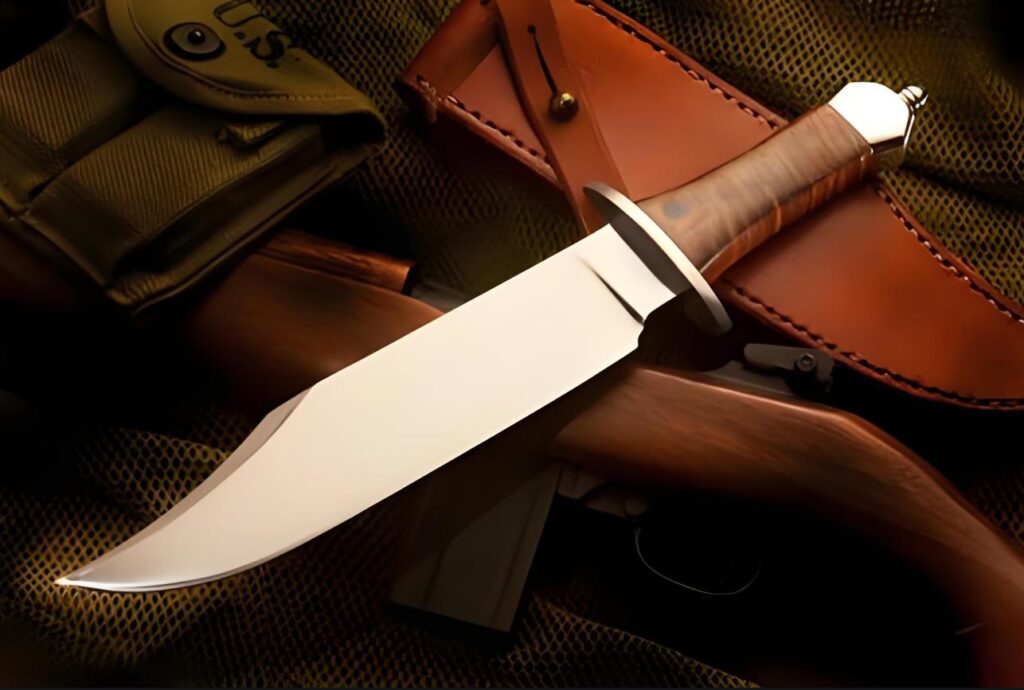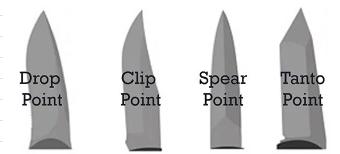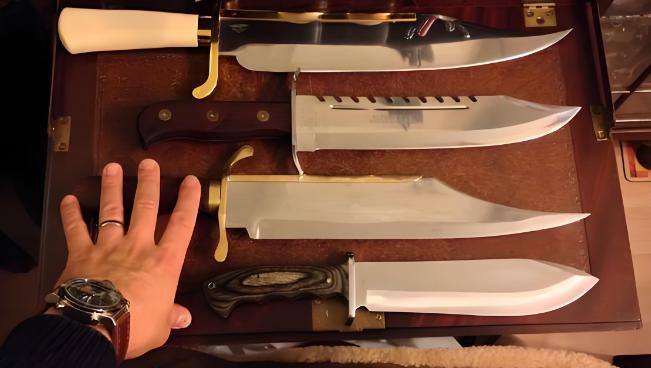Introduction
The clip-point blade is one of the most popular and versatile blade shapes used in a wide range of knives. Known for their sharp, controllable tip and excellent piercing ability, clip point blades have a rich history and are favored by many knife enthusiasts, hunters, and tactical users.
But what sets it apart from other blade shapes? What are the key advantages and disadvantages of clip point blades compared to other blade shapes like the drop point?
In this comprehensive guide, we’ll explore the origins, characteristics, uses, and comparisons of clip-point blades, revealing the secrets behind this timeless and versatile blade design.
History and origins of clip point blades

Early Use
The clip-point blade has been a staple in American knife design since the early 19th century, with the iconic Bowie knife being one of the most famous examples. Designed by Rezin Bowie for his brother Jim Bowie, a legendary frontiersman and fighter, the Bowie knife featured a large clip-point blade that was well-suited for hunting, fighting, and utility tasks.
Evolution of Modern Designs
In the 20th century, advancements in metallurgy and knife-making techniques led to more refined and specialized clip-point blades. Knifemakers like Bo Randall and William Scagel popularized clip-point hunting knives mid-century, using high-carbon tool steels for durability and sharpness. Today, clip-point blades are found on a wide array of knives, from classic slip-joint folders to modern tactical knives, showcasing the timeless versatility of this iconic blade shape.
Characteristics of Clip Point Blades

Blade Tip Shape and Curvature
The defining feature of a clip point blade is the concave curvature or “clip” on the spine of the blade near the tip. This clip creates a sharper, thinner point compared to other blade shapes. The sharp tip provides excellent control for detail work and allows the blade to pierce materials easily.
Aesthetics and personalization
Clip-point blades excel in aesthetics and personalization. Their iconic shape catches the eye and evokes thoughts of adventure, a good example we already mentioned is the bowie knife, which plays an important role in American history and culture.
Manufacturers and bladesmiths also use its unique shape as a canvas for artistic engraving, giving each knife a distinct personality. Surface treatments like stone washing or acid etching enhance visual interest and improve durability. Personalization options are endless, with various handle materials and unique blade materials like Damascus steel.
Pros and Cons
The clip point blade is a great jack-of-all-trades blade, Some even claim that it surpasses the drop point blade in terms of versatility. By removing material from the spine near the tip, the point becomes more refined and sharp, enhancing its piercing ability. Despite that, the blade maintains its curved belly, allowing for efficient slicing and chopping. These designs strike a balance between piercing precision and cutting efficiency, making it a well-rounded choice for various tasks.
That said, the clip point blade is not without its drawbacks. For example, the thin tip can be more prone to breaking if used for prying or heavy-duty tasks. Additionally, the sharp point may not be ideal for some utility tasks that require a blunter tip.
Uses of Clip Point Blades

Cutting and Slicing
The clip point blade’s sharp edge and ample belly make it an excellent choice for cutting and slicing tasks. Whether cutting through rope, preparing food, or field dressing game, this kind of blade provides the necessary control and slicing ability. In addition, the narrow point of clip point blade is ideal for small game, allowing some very detailed cutting or cut something inside a very small crevice or space.
Piercing and Stabbing
The defining characteristic of a clip point blade is a concave curvature on the spine near the point, creating a sharply pointed tip. This design concentrates force on a smaller area, making it ideal for puncturing and piercing tasks. This makes clip-point blades popular for self-defense and tactical applications, where the ability to penetrate deeply is crucial.
Hunters also appreciate the piercing ability when field dressing game or skinning hides. This also them to quickly penetrate skin and muscle tissue during the field dressing and butchering of game.
Types of Knives Using Clip Point Blades

Hunting Knives
Clip point blades are a favorite among hunters, some even prefer the clip point’s performance over the drop point blade, which is often considered the most versatile hunting blade. As mentioned before, The clip point design offers unmatched versatility across a wide spectrum of game sizes.
However, be mindful that its sharp point can puncture hide if not used with care. Moreover, the narrow tip may be more susceptible to breaking or chipping if used for heavy-duty tasks like splitting bone. Nevertheless, this may be a big problem for experienced hunters.
Start Working with a Professional Now
Everyday Carry (EDC) Knives
Many popular EDC knives feature clip-point blades due to their versatility and usefulness in daily tasks. Thanks to their sleek profile, they slip into your pocket with ease and are ready at a moment’s notice for a multitude of everyday tasks. Folding knives with clip-point blades offer a compact, convenient option for carrying in a pocket or on a belt.
Besides, these knives are designed for everyday tasks, such as opening packages, cutting rope, or whittling. The clip-point blade’s sharp tip and slicing ability make it a versatile choice for these applications.
Tactical and Military Knives
Tactical and military knives often employ clip point blades for their piercing ability and overall versatility. For instance, In high-stress, unpredictable environments such as battlefields, a reliable, multi-purpose knife is essential. Whether cutting through ropes, opening containers, or defending oneself in close-quarter combat, a clip point blade can effectively handle the task at hand.
Clip point vs drop point, which one is good for self-defense?
For self-defense, a clip point blade is often chosen for its sharp and pointy end which can be advantageous for piercing. Drop point blades, on the other hand, have a stronger tip and could be more durable in rough situations.For someone trained in precise and controlled stabbing techniques, a clip point blade might be preferred due to its ability to quickly penetrate. On the other hand, if the user anticipates a need for a more robust blade that can handle a variety of situations without the risk of the tip breaking, a drop point might be the better option.
Comparing Clip Point Blades to Other Blade Shapes

Clip Point vs. Tanto
Tanto blades have a sharp, angled tip that is designed for piercing tough materials. While tanto blades excel at piercing, they lack the slicing ability of clip point blades due to their straight edge. Clip point blades offer a more versatile option for both piercing and slicing tasks.
Clip Point vs. Drop Point
Drop point blades have a convex curve on the spine of the blade, creating a lowered point. This blade shape offers excellent slicing ability and a strong, broad tip. While drop point blades are more durable than clip points, they lack the precise control and piercing ability of the clip point design.
Clip Point vs. Spear Point
Spear point blades have a symmetrical design, with the point aligning with the center of the blade. This creates a strong, sharp tip that is ideal for piercing. However, spear point blades lack the slicing ability of clip point blades due to their straight edges. Clip point blades offer a more versatile design for both piercing and slicing.

Clip Point vs. Wharncliffe
Wharncliffe blades have a straight edge that curves upward to meet the spine at the tip, creating a fine point for piercing and detail work. The straight edge excels at slicing against flat surfaces. Clip point blades have a more curved edge and a sharper, thinner tip for better control when piercing. The choice between the two depends on the specific tasks you intend to perform.
Having Clip Point Blade Knives in Your Arsenal

When choosing a knife with a clip point blade, consider the intended use and select a knife with a quality blade steel, sturdy construction, and comfortable handle. With proper care and maintenance, a clip point blade knife can provide years of reliable service for all your cutting and piercing needs.
If you’re a wholesaler, retailer, or brand merchant looking to enhance your product line with knives like these, then consider the benefits of sourcing from China.
With services including wholesale, OEM, and private labeling, you can expand your offerings efficiently. Also, we connect you with the most reliable suppliers.
Interested in learning more? Reach out to us for a free quote and let’s discuss how we can meet your procurement needs.

